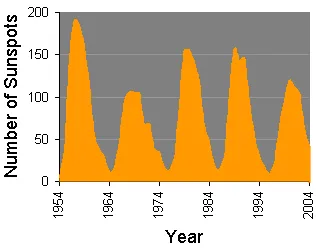Solar Variation
We tend to think of the Sun as steady, dependable, and never-changing. "As sure as the Sun will rise tomorrow" is our way of indicating absolute certainty. However, our Sun does change over time, though most humans are unaware of those changes for the most part. Some of those changes occur on time scales of hours or days. Others occur at rates measured in years or centuries, or even over the course of the multi-billion year history of the Sun. Some of the changes are regular and cyclic, while others are irregular and chaotic. Since the amount of energy our planet receives from the Sun is such a crucial ingredient in the behavior of Earth's climate, let's examine some of these changes in our solar system's furnace.

Annual sunspot counts for 50 years, showing the 11-year sunspot cycle.
Randy Russell, UCAR
The Sunspot Cycle
Galileo was amongst the first to employ a telescope in making solar observations, and was deemed a heretic for (amongst other things) noting that the face of the Sun, which should have been (in the eyes of the church in that era) a perfect heavenly orb, had blemishes. Sunspots periodically march across the face of the Sun, and in fact were used to make the earliest measurements of the Sun's rotation rate. Over short time spans, the numbers, sizes, and locations of these spots seem to vary in unpredictable ways. However, by the mid-1800s astronomers realized that the number of sunspots waxed and waned in a cyclical fashion, which they soon determined had a periodicity of roughly 11 years.
Sunspots are actually visual manifestations of tangled magnetic fields on the Sun. The Sun has an overall dipole (two magnetic poles, like a bar magnet) field similar in many ways to Earth's. However, the Sun, being a large ball of gas (or more accurately, plasma), does not all rotate at the same rate as does a solid sphere like Earth. The Sun rotates more rapidly at the equator (with a 27 day period) than it does at the poles (where the period is around 31 days). Over time, this differential rotation rate causes the Sun's magnetic field to become "all tangled up". The tangles are visually manifested as sunspots; regions of intense magnetic fields over a thousand times more powerful than the Sun's general field, where hot matter flowing up to the photosphere from the underlying convection zone is prevented from entering. Since the material in these regions is not refreshed by new, hot plasma from below, it cools and thus appears darker. Darker, at least, in the visible light portion of the spectrum. These zones of intense magnetism tend to spawn energetic disturbances in the Sun's atmosphere, unleashing vast solar storms (solar flares and Coronal Mass Ejections) that emit large blasts of X-ray and ultraviolet radiation.